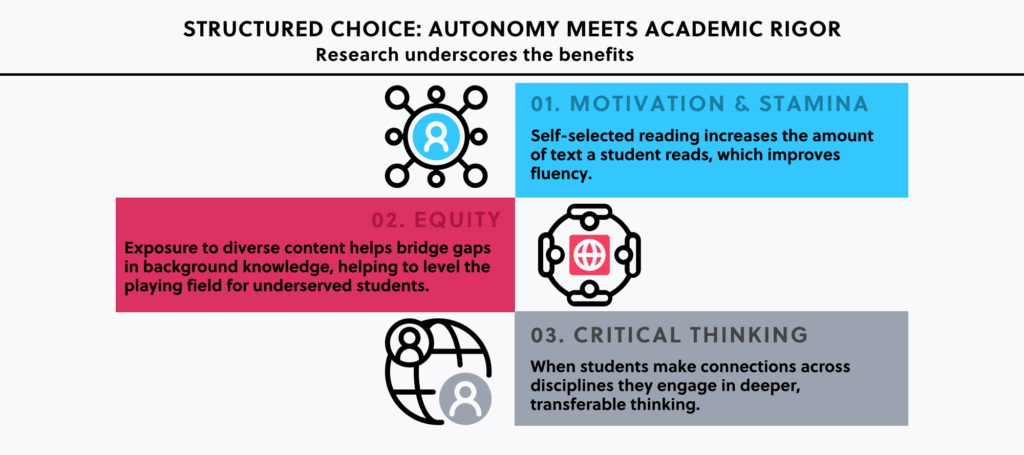The Case for Structured Choice
Reading comprehension is often misrepresented as a standalone skill, assessed through isolated strategies like identifying main ideas or summarizing the text. However, decades of research reveal a deeper truth: comprehension hinges on what students already know. Background knowledge—facts, vocabulary, and conceptual understanding—empowers readers to infer, analyze, and retain information. Yet all too often, exposure to a wide range of content is treated as incidental, resulting in critical gaps in students’ ability to grasp complex texts. Teachers often find themselves at the mercy of what their students have been exposed to before they arrive in their classrooms. To bridge the gaps that often exist, educators need access to a rich library of content that simultaneously meets students where they are in their reading ability and interests and spans a broad range of topics. In short, kids don’t just need to learn how to read—they need to learn about the world to become better readers.
The Knowledge Gap: Why Content Matters

To illustrate the importance of background knowledge, consider the example of a student reading about the Apollo 11 mission, placing a seismometer on the moon. Without prior knowledge of the Apollo space program or scientific instruments, decoding the words becomes a fairly empty exercise. But with even basic familiarity, the passage transforms into a meaningful narrative. This principle is well-documented. Studies show that students with domain-specific knowledge outperform stronger readers lacking such context. 1
“…students with domain-specific knowledge outperform stronger readers lacking such context.”
And further research confirms that vocabulary, topic familiarity, and text structure awareness are stronger predictors of comprehension than generic “skills.”2
Structured Choice: Autonomy Meets Academic Rigor
Traditional approaches often pit student agency against curricular demands, but structured choice resolves this tension. By allowing students to select texts from a curated, knowledge-rich library—spanning science, history, culture, civics, and current events—educators can foster engagement while ensuring exposure to critical content. The Juice offers exactly this. Its team of experienced educators and journalists hold a daily editorial meeting to determine a lineup of current event stories that strike an intentional balance of topics that span across the curriculum. Educators who’ve implemented The Juice have seen the benefits firsthand. “I liked that students could choose their own learning path with the articles they wanted to read, and it was also good that I could see how students were doing on the quizzes,” stated Rachel Zack of Horizons National. “It was great that The Juice was student-centered, and the students appreciated it too.” Her experience underscores the powerful balance between autonomy and accountability that structured choice enables.

Research underscores the benefits:
- Motivation & Stamina: Self-selected reading increases the amount of text a student reads, which improves fluency.
- Equity: Exposure to a diverse content base can help bridge longstanding gaps in background knowledge among students, helping to level the playing field for underserved students.
- Critical Thinking: When students make connections across disciplines, such as linking the process of photosynthesis in science to discussions about climate change in social studies, they engage in deeper, transferable thinking.

A Blueprint for Implementation
To maximize the potential of structured choice, schools should:
- Ensure Access to Quality Content: Prioritize resources offering daily, grade-level appropriate passages across disciplines. Learning is cumulative. The more students know, the easier it is for them to learn and comprehend even more. Daily exposure to diverse topics fuels a virtuous cycle of knowledge acquisition.
- Integrate Strategy Instruction: Pair choice reading with explicit lessons on inferencing, summarizing, and questioning. Contextualizing these strategies within student-selected texts deepens their relevance.
- Assess Holistically: Move beyond quizzes and annotations. Use discussions, reflective writing, and knowledge-based projects to better evaluate comprehension and critical thinking.
Reading comprehension isn’t a skill to be drilled—it’s the product of knowledge, curiosity, and practice.
“Reading comprehension isn’t a skill to be drilled—it’s the product of knowledge, curiosity, and practice.”
Structured choice reading, anchored in a content-rich framework, offers a sustainable solution. It harnesses student interest while systematically expanding the foundational knowledge needed to decode our information-rich world. By embracing this approach, educators can transform classrooms into spaces where students don’t just learn to read—they read to learn.
"*" indicates required fields
- Recht, Donna R., and Lauren Leslie. “Effect of Prior Knowledge on Good and Poor Readers’ Memory of Text.” Journal of Educational Psychology, vol. 80, no. 1, 1988, pp. 16–20.
↩︎ - Smith, R., Snow, P., Serry, T., & Hammond, L. (2021). The Role of Background Knowledge in Reading Comprehension: A Critical Review. Reading Psychology, 42(3), 214–240. ↩︎



